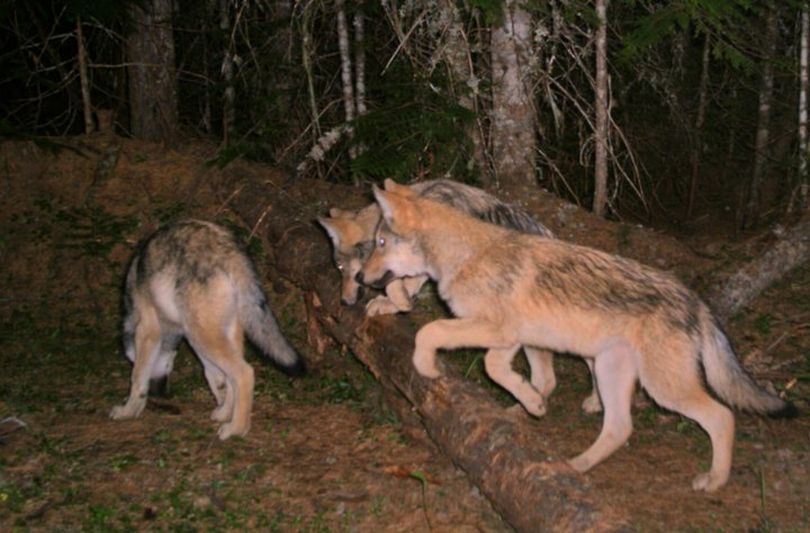Fourth breeding wolf pack confirmed in Washington

ENDANGERED SPECIES -- Washington’s fourth documented breeding wolf pack has been confirmed, this one in Kittitas County, the Washington Fish and Wildlife Depatment just announced.
Last month, agency biologists caught, attached a radio collar and released an adult female wolf that was lactating, indicating she was nursing pups. The biologists took tissue and hair samples and submitted them for DNA testing to determine whether the animal was a wild wolf or a wolf-dog hybrid.
Results of the DNA testing conducted at the University of California-Davis confirmed the animal is a wild gray wolf, the agency says in a prepared release.
WDFW biologists are monitoring the wolf’s location and activity through the radio telemetry tracking collar. They are referring to the new wolf pack as the Teanaway Pack.
The Lookout Pack, confirmed in Okanogan and Chelan counties in 2008, was Washington’s first documented resident pack since a breeding population of wolves was extirpated from the state in the 1930s.
A second pack, known as the Diamond Pack, was documented in 2009 in central Pend Oreille County.
A pup from a third pack, known as the Salmo Pack, was radio-collared in 2010 in northeast Pend Oreille County, where pack territory ranges into British Columbia.
Wolves from the Cutoff Peak Pack, with a den site in Idaho, range into Pend Oreille County in northeast Washington.
This announcement of a new wolf pack in the Cascades comes on the heels of reports that only two animals remain in the original Lookout Pack. Authorities believe the Lookout Pack's numbers were severely reduced by illegal killing.
“The discovery of another resident wolf pack clearly indicates that wolves are returning to Washington state naturally,” said WDFW Director Phil Anderson. “Their return highlights the need to continue efforts to finalize a state wolf conservation and management plan that will establish state recovery objectives and describe options for addressing wolf-livestock and wolf-ungulate management issues.”
Read on for more details.
The gray wolf (Canis lupus) is protected throughout Washington as a state endangered species. In the western two-thirds of Washington, the species is also federally protected under the Endangered Species Act (ESA).
Before the Teanaway Pack was confirmed, WDFW estimated a total of about 25 resident wolves in the state.
WDFW has been working since 2007 with a 17-member citizen group to develop a wolf conservation and management plan in anticipation of wolves re-entering Washington from other states or Canada. A draft plan, which underwent extensive public review and scientific peer review, will be presented to the Washington Fish and Wildlife Commission in August.
For more information on the draft plan, see http://wdfw.wa.gov/conservation/gray_wolf/.
Harriet Allen, WDFW’s threatened and endangered species program manager, said the search for the Teanaway pack was prompted by reports of wolves in the area from citizens and state and federal agency personnel.
Remote, motion-triggered cameras were deployed by multiple agencies and private groups. Images of wolf-like animals were captured on cameras placed in the area by Conservation Northwest, a private, non-profit organization. The group’s Citizen Wildlife Monitoring Program also provided the first images of the Lookout Pack pups three years ago.
“We appreciate the efforts of Conservation Northwest and our partner agencies, the U.S. Forest Service and U.S. Fish and Wildlife Service, to help us document wolves as they return naturally to Washington,” Allen said. “Documenting packs and learning about territory use, productivity and survival will help us understand how wolves are using Washington habitat. That will help us protect them and ultimately determine when we reach recovery goals.”
Wolf sightings or activity should be reported through the joint federal-state toll-free wolf reporting hotline at (888) 584-9038.
Joint federal-state Wolf Response Guidelines, including agency staff contacts, are available online.
It is illegal to harm or harass a federal- or state-protected endangered species.
